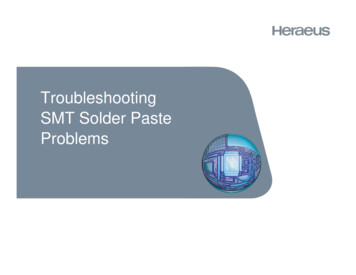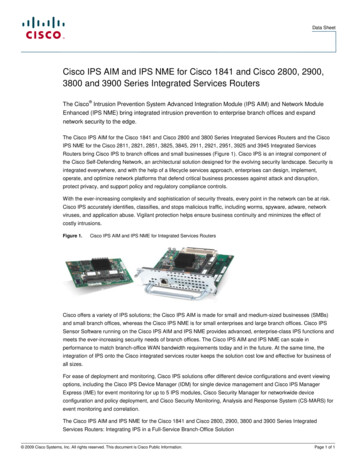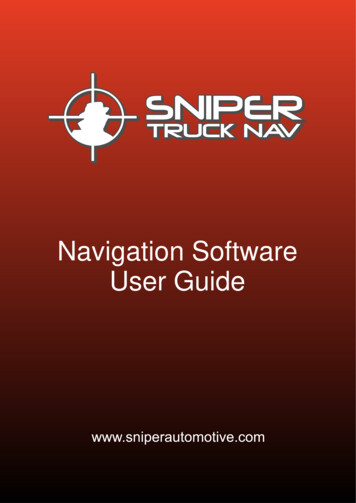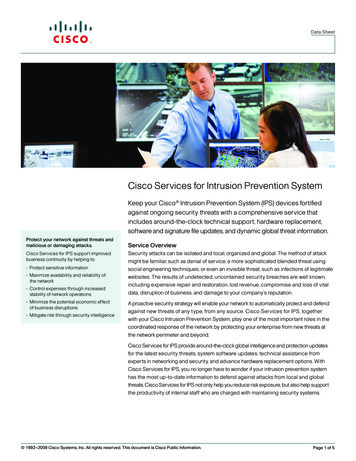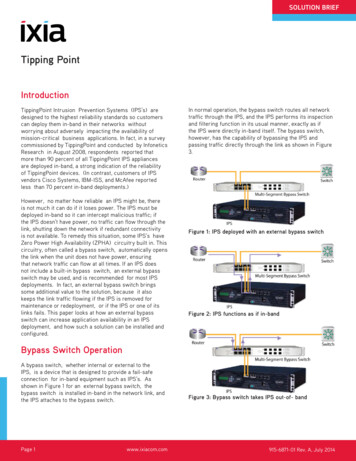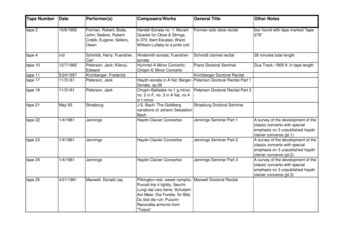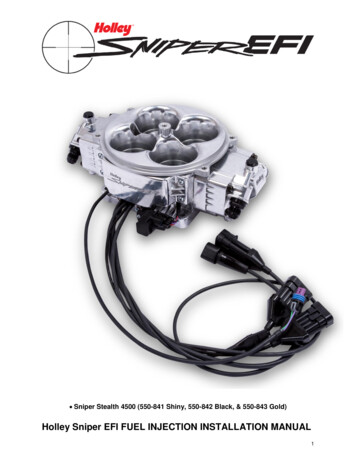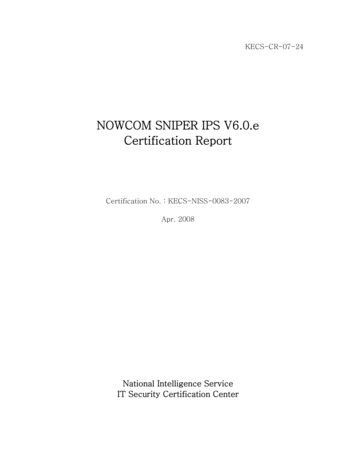
Transcription
KECS-CR-07-24NOWCOM SNIPER IPS V6.0.eCertification ReportCertification No. : KECS-NISS-0083-2007Apr. 2008National Intelligence ServiceIT Security Certification Center
No.00Alteration/Amendment HistoryAlteration DatePageDescription2007.12.21First written012008. 2.18-022008. 4.1114pChange in company name (Wins Technet.Co.,Ltd Æ Nowcom Co., Ltd.)Security Target Version altered(1.03Æ1.04)Certification Validity Maintenance(Alteration approved) Added
This document is the certification report for SNIPER IPS V6.0.e of the NOWCOM Co.,Ltd.Certification CommitteeMinistry of Information and Communication (Chong Jong-Ki), National SecurityTechnology Lab (Park Jong-Wook), Korea Institute of Science and Technology (ChaSung-Duk), Yonsei University (Song Joo-suk) Korea University (Lee Dong-hoon),Sungshin Women’s University (Seo Dong-soo), Hannam University (Lee Kang-soo),Soonchunhyang University (Lee Im-young), Electronics and TelecommunicationResearch Institute (Chong Kyo-il)Certification BodyNational Intelligence Service IT Security Certification CenterEvaluation BodyKorean Information Security Agency
Table of Contents1. Overview .12. TOE Identification. 23. Security Policy .44. TOE Assumptions and Scope. .45. TOE Information. . . . .56. Guidance. . . 57. TOE Test . . . .88. Evaluation Configuration . .99. Evaluation Result . 1010. Recommendations . 1111. Acronyms and Glossary .1212. Reference . 13
1. OverviewThis report is for the certification body to describe the certification result, whichinspects the result and the conformance of the EAL4 evaluation of SNIPER IPS V6.0.ewith regard to the Common Criteria for Information and Technology Security Evaluation(May 21, 2005)(hereunder referred to as ‘Common Criteria’).The Korea Information Security Agency (KISA) has finished the evaluation of theSNIPER IPS V6.0.e on Nov. 30, 2008. This report is written based on the EvaluationTechnical Report (ETR) produced and provided by KISA. The evaluation concludes thatthe TOE satisfies the CC V2.2 part 2 and EAL4 of the CC V2.2 part 3 assurancerequirements; thus, it is assigned the verdict “pass” on the basis of the paragraph 191 ofthe CC V2.2 part 1. In addition, the TOE satisfies the Network Intrusion PreventionSystem Protection Profile V1.1 (Dec. 21, 2005).SNIPER IPS V6.0.e is a hardware integrated product developed by NOWCOM Co., Ltd.that provides intrusion detecting/blocking functions. The TOE is installed in an In-Linemode at the network section where it targets to protect, and is managed via the web-basedGraphic User Interface (GUI).The TOE provides the following security functions:-Security Audit (WFAU)USER Data Protection (WFDP)Identification and Authentication (WFIA)Security Management (WFMT)TSF Protection (WFPT)The certification body has examined the evaluation activities and testing procedures,provided the guidance regarding the technical problems and evaluation procedures, andreviewed each evaluation work package and evaluation technical report. In conclusion,the certification body has confirmed that the evaluation results gave assurance that theTOE meets all security functional requirements and assurance requirements described inthe Security Target (ST). As a result, the certification body has certified that theevaluator’s observations and evaluation results were accurate and reasonable, and hisverdict on each package was correct.Certification Validity: The information contained in this certification report does notmean that the use of SNIPER IPS V6.0.e is approved or its quality is guaranteed bygovernment agency of the Republic of Korea.2. TOE IdentificationThe following [Table 1] indicates the information of the TOE identification.
[Table 1] TOE IdentificationKorea IT Security Evaluation and Certification Guidance(May 21, 2005)Evaluation GuideKorea IT Security Evaluation and Certification Scheme (Apr.15, 2007)TOESNIPER IPS V6.0.eNetwork Intrusion Prevention System PP V1.1 (Dec. 21,Protection Profile2005)Security TargetSecurity Target V1.04 (Jan. 16, 2008), NOWCOM Co., Ltd.ETRSNIPER IPS V6.0.e ETR, V1.0 (Nov. 30, 2007)Satisfies the CC part 2Evaluation ResultSatisfies the CC part 3Common Criteria for Information Technology SecurityEvaluation CriteriaEvaluation V2.3 (Aug. 2005)Common Methodology for Information Technology SecurityEvaluation MethodologyEvaluation V2.3 (Aug. 2005)SponsorNOWCOM Co., Ltd.DeveloperNOWCOM Co., Ltd.KISA Evaluation Center, Evaluation Team IIEvaluation TeamYongsuk Oh, Hyunmi ParkCertification BodyNational Intelligence Service
Underlying Hardware specifications are stated in the [Table 2].ServerClient[Table 2] SNIPER IPS V6.0.e Server and Client Intel Xeon DP CPUIntel Xeon DP CPUCPU3.0GHz * 23.6GHz * 2HardwareMemory2G DDR-II2G DDR-IIHDDSATA 200GB3.5” 73GB(SCSI) * 2DOM512MB512MBNo. of port 10/100/1000Mbps 1port 10/100/1000Mbps 1portHA10/100/1000Mbps 1port 10/100/1000Mbps 1portPortL7 HA.10/100/1000Mbps 2portMonitoring1000 Mbps 4port1000 Mbps 4portSoftwareOSSNIPER OS V1.0 (Proprietary OS)CPUIntel Pentium IV 1.8GHz or higherMemory512MBH/WHDD40GB or moreNo. of port10/100 NIC 1 or moreS/WOSMS Windows XP professionalSince the SNIPER Client is automatically installedas downloading OCXs from the SNIPER Server,the administrator PC needs to have IE 7.0 or higherCharacteristicsinstalled.Also, the administrator PC needs to have 1024x768and higher resolution, sound card, and speaker.
3. Security PolicyThe TOE operation conforms to the security policies stated below.NameAuditSecure manageSSL (CertificatemanagementDescriptionIn order to trace responsibilities regarding all actions related tothe security, security related events shall be recorded andmaintained, and the recorded data shall be examined.An authorized administrator shall manage the TOE in a securemanner.SNIPER shall securely generate the SSL Certificate and thereforestore, manage it.4. TOE Assumptions and Scope4.1 AssumptionsThe TOE installation and operation should conform to the assumptions stated below.NameDescriptionThe TOE shall locate in a physically secure environment whereA.Physical securityonly authorized administrators are allowed to access.When the local network environment goes through any changes dueto the alterations of the network structure, increase or decrease ofA.Securityhosts/services, the new changes are immediately noted and securityMaintenancepolicies are configured in accordance with the TOE operationalpolicy to maintain the same level of security as before.Trusted administrators ensure reliability and stability of theA.Trustedoperation system by eliminating all services or means that are notadministratornecessary for the TOE and by providing the OS vulnerabilitypatches.The underlying OS of the TOE ensures the reliability and stabilityA.Hardened OSby eliminating all services or means that are not necessary for theTOE and by providing the OS vulnerability patches.The TOE, when installed and operated in a network, separates theA.Singlenetwork into remote and local sections. All traffic between theConnection Pointremote and the local sections pass through the TOE.The IT environment of the TOE is provided with a reliableA.TIMETimestamp from the NTP server which conforms to RFC 1305 orfrom the OS.The TOE, when installing the certificate that is to be used for theA.TOE SSLSSL authentication, generates in advance and stores at the TOE.CertificateSSL Certificate of the TOE is safely generated and managed.
4.2 Scope to Counter a ThreatThe TOE provides a means to countermeasure the security threats including assetviolation attempts of the TOE itself that is under protection. The TOE provides means toprotect the local network from the attacks exploiting new vulnerabilities or the attackscapable to bypass the security. The TOE provides a countermeasure for thelogical/physical attacks caused by the malicious user possessing low-level expertise,resources, and motivation.All security objectives and security policies are described to provide a means to counteran identified security threat.5. TOE InformationThe TOE supports the security function of intrusion detection and firewall.Operation environment is illustrated in the following [Image 1], and the basic structurefollows the [Image 2] below.[Image 1] SNIPER IPS V6.0.e Operation network environment
[Image 2] SNIPER IPS V6.0.e Basic structureThe TOE consists of the following main subsystems. Audit (WFAU)Security audit subsystem operates the function of audit data generation (WFAU GEN)and audit data inquiry (WFAU SAR). In order to check whether a system operatesefficiently, by gathering, analyzing the record history, audit records generated through theaudit detect/block intrusions to the computer system and are used for detecting the misusefor the system. User Data Protection (WFDP)User Data Protection sub-system operates Firewall function (WFDP FFU), Blackholeblocking (WFDP BLK), QoS blocking (WFDP QOS), Intrusion Detecting function(WFDP DET), Intrusion Analyzing function (WFDP ALS), and IntrusionCountermeasure function (WFDP ACT). This function controls the flow of network dataaccording to the permission or blocking rule to protect the target network that is to beprotected from internal or external attackers. Also it collects information to detectintrusion and react to an intrusion in case it is identified, and stores the analysis result sothat the administrator can check. Identification and Authentication (WFIA)Identification and Authentication sub-system operates user identification andauthentication process (WFIA ACCESS). Only authorized administrators are allowed to
access key functions that are essential to the regular operation of SNIPER such aschanging, deleting and adding policies and retrieving log files. In order to control theaccess to SNIPER perfectly, every access attempt through an administrator interface areexamined to identify and authentication appropriate administrator. The communicationbetween SNIPER Client and the engine is encrypted using SSL and its integrity isverified through SHA-1 to prevent any modification or exposure of the data. Even withthe access of an authorized administrator, if not operate for a certain period of time;protect the TOE during the inactive terms of an authorized administrator by locking upthe interacting sessions. Security Management (WFMT)Security Management sub-system operates Security Audit Management(WFMT AUDIT),OS Configuration(WFMT CONFIG), Management of Security ViolationList(WFMT POLDET), Firewall function Management(WFMT POLFW), Managementof Interoperation between ESM and the Control Server regarding security violationevents(WFMT ESM), Update(WFMT UPD), and QoS Policy(WFMT POLQOS).Security Management function provides the rules for detection/prevention SNIPERperforms and the managerial actions retrieving and modifying information related to thestate and configuration of SNIPER. TSF Protection (WFPT)TSF Protection sub-system operates TSF stored data Integritycheck(WFPT INTSTDATA), TSF transmitting data Integritycheck(WFPT INTTRDATA), Prevention of audit data loss(WFPT CHKDB), Abstractmachine testing(WFPT ATM), and IPS status information(WFPT CHKSYS). TSFProtection provides a regular check function to assure that the security assumptionsrelated to the underlying abstract machine are properly operating. It performs checkingwhen initially started, periodically during normal operation, and upon request of anauthorized user to decide whether the main components running on the TOE system arenormally operating in order. It also preserves a secure state when failure occurred andensures safe operation of the TOE by periodical monitoring. In cases where componentsof the TOE interact remotely through internal communication channels, Server and Clientidentify and authenticate the nodes of the other side to ensure safe channels betweenTSFs.
6. GuidanceThe TOE includes following documents. SNIPER IPS V6.0.e Administrator Guidance V1.02, 2007. 10. 2SNIPER IPS V6.0.e Delivery documentation V1.01, 2007. 7. 18SNIPER IPS V6.0.e Installation Manual V1.1, 2007. 10. 57. TOE TestDeveloper’s Test Testing MethodThe developer produced the test considering the security function of the TOE. Each testis described in test documentation including the following items in detail.- Test No./Tester: The identifier of the test and the developer who participated in testing- Purpose of the test: Describes the purpose of the test including security function andsecurity module to be tested.- Test configuration: Detailed environment where the test is carried out- Detailed test procedure: Detail procedure to test security functions.- Expected result: Test result expected when performing the test procedure.- Actual result: Test result acquired when the test is performed.- Comparison of the expected result and the actual result:The evaluator performed a thorough evaluation of the validity such as the testconfiguration, test procedure, test scope analysis, and the low-level design test. Theevaluator verified that the developer’s test and its results were adequate for the evaluationconfiguration. Test configurationThe test configuration described in the test documentation includes the detailedconfiguration such as the organization of network for the test, the TOE, theinternal/external network. In addition, it describes detailed test configuration such as testtools required to perform each test. Test Scope Analysis/Low-level Design TestThe detailed evaluation results are described in the ATE COV and ATE DPTevaluation result. Test ResultThe test documentation describes the expected and the actual result of each test. Theactual result is confirmed through the audit record as well as the GUI TOE.
Evaluator’s TestThe evaluator installed the TOE using the evaluation configuration and evaluation toolsidentical to those of the developer test and performed testing for the overall tests providedby the developer. The evaluator confirmed that the actual result of every test wasconsistent with the expected result.Moreover, the evaluator devised and performed additional evaluator’s tests on the basisof the developer’s test, and confirmed that the actual test result was consistent with theexpected test result.The evaluator carried out the vulnerability test and confirmed that there was noexploitable vulnerability in the evaluation configuration.The evaluator’s test result assured that the TOE worked normally as described in thedesign documentation.8. Evaluation ConfigurationFor testing, the evaluator composed the following test configuration that corresponds tothe environment structure specified on the Security Target.
[Image 3] TOE test configuration9. Evaluation ResultThe evaluation is on the basis of the Common Criteria for Information TechnologySecurity Evaluation, Common Methodology for Information Technology SecurityEvaluation. It concludes that the TOE satisfies the CC part 2 and EAL4 of the CC part 3assurance requirements. The detailed information regarding the evaluation is described inthe ETR. ST Evaluation (ASE)The evaluator applied the ASE sub-activities described in the CEM V2.2 to theevaluation of the ST of the TOE. The ST provides a logical description of the TOE; that itis internally consistent and consistent with other parts of the ST. The TOE securityenvironment provides definition of the consistent, complete security issues that areinduced from the TOE and the TOE security environment. The security objectives arealso described completely and consistently. The security objectives counter the identifiedthreats, achieve the organizational security policies, and satisfy the stated assumptions.The TOE security requirements and the security requirements for the IT environment are
described completely and consistently and provide an adequate basis for the developmentof a TOE that will achieve its security objectives.TOE summary specification provides security function and assurance standard with anaccurate and consistent superior level definition, satisfies described TOE securityrequirements. Also, it accurately substantializes Protection Profile that the SecurityTarget accepts. Configuration Management Evaluation (ACM)The evaluator applied the ACM sub-activities described in the CEM V2.2 to theevaluation of the configuration management of the TOE. The evaluator verified that theconfiguration management specifies the configuration list, configuration identification,version endowment, configuration modification control and that all developmentdocumentations and source files were developed applying the configuration managementsystem. He also confirmed that the generation and modification of the configurationitems are achieved through the configuration management organization and theconfiguration management system. Delivery and Operation Evaluation (ADO)The evaluator applied the ACM sub activities described in the CEM V2.2 to theevaluation of the development of the TOE. The Delivery and Operation describesmeasures and procedures of the secure delivery, installation, and operation. Thus, itensures that the security is not being damaged while the TOE is transmitted, installed,operated, and it verifies that the contents of the document are being actually appliedaccording to the results of inspections. Development Evaluation (ADV)The evaluator applied the ADV sub-activities described in the CEM V2.2 to theevaluation of the development of the TOE.Development evaluation defines as it specifies the TOE security functional requirementsfrom the TOE summary specification to the actual implementation stage, using functionalspecification, high-level design, low-level design, and implementation representation.The security policy modeling clearly and consistently describes the rules andcharacteristics of the security policies; this description corresponds with the securityfunctions described in the functional specification. Guidance Evaluation (AGD)The evaluator applied the AGD sub-activities in the CEM V2.2 to the evaluation of theguidance of the TOE. The administrator guidance describes the method of how theadministrator may access to the security management interface. It also describes theguidelines and rules regarding the each provided menu by giving examples. Theadministrator guidance has verified that the contents described are being accuratelyoperated. Also, as the TOE does not request the user guidance for security requirements,it is impossible to apply user guidance evaluation. Life Cycle Support Evaluation (ALC)
The evaluator applied the ALC sub-activities described in the CEM V2.2 to theevaluation of the life cycle support of the TOE. The life cycle support evaluation clearlydescribes that it protects the development environment using security measures, such asprocedures, policies, tools and methods regarding the every stage of the TOEdevelopment. Through the actual inspection process of the institutions, it verified that theabove statements were actually being applied. Tests Evaluation (ATE)The evaluator applied the ATE sub-activities described in the CEM V2.2 to theevaluation of the test of the TOE. The test documentation predicts the result anddescribes the objectives of the test, progressive test procedures, and the test resultsregarding the security functions specified on the ST. By performing module test and theprovided development functional test repeatedly, the evaluator verified that the contentsof the test described in the test documentation was accurate and that the securityfunctional actions implemented during the development were consistent. Also, byperforming independent testing, the evaluator confirmed accuracy of the developer’s test. Vulnerability Assessment Evaluation (AVA)The evaluator applied the AVA sub-activities described in the CEM V2.2 to theevaluation of the vulnerability assessment of the TOE. The vulnerability analysisdocument reasonably and specifically describes the identified vulnerabilities of the TOEand appropriate countermeasures, analysis and countermeasures of the misuse. Also, byconducting independent vulnerability analysis, the evaluator confirmed the accuracy ofthe vulnerability analysis. Also, the strength of TOE security function analysis describesthat the strength of TOE security function satisfies the functional strength permit leveldefined at the PP/ST.10. Recommendation In order for the SNIPER Client to operate under a normal condition, administrator pcshall be installed with the Windows Explorer 7.0 or higher version. Furthermore,even though not included in the evaluation scope, administrator pc needs to haveCrystal Report, Tee Chart, Quick Report, Microsoft Excel installed to make the fulluse out of the security functions that the SNIPER Client provides. In this evaluation report, SNIPER IPS V6.0.e has performed a thorough evaluation onthe 2 models, E2000 and E4000. E4000 includes an additional HA function, whichenables transmission of the sessions to the backup device, allowing continuous activeoperation of the network protection. A1000, A2000, and A4000 models are the prototypes of the current E-series. All Aseries support the SPAN mode, an IPS function that allows bypassing the inline mode.SNIPER IPS V6.0.e does not support the SPAN mode. Since the malicious traffic can inbound due to the incorrectly configured thresholdvalue, it is crucial that the administrator configure the threshold value most suitablefor the network environment.
SNIPER provides live update function for updating the latest attack patterns.Administrator needs to perform periodical pattern updates to maintain SNIPER automatically alarms the administrator if the traffic exceeds the thresholdvalue. However, we highly recommend that the administrator shall periodically checkthe status of the storage space and make sure whether it has enough room for savingaudit records.11. Acronyms and GlossaryThe following acronyms are used in this certification report.(1) AcronymsCCEALPPSOFSTTOETSCTSFTSPCommon CriteriaEvaluation Assurance LevelProtection ProfileStrength of FunctionSecurity TargetTarget of EvaluationTSF Scope of ControlTOE Security FunctionsTOE Security Policy(2) GlossaryTOEAn IT product or system and its associated guidance documentation that is the subject ofevaluation.Audit recordAudit data to save an auditable event relevant to the security of the TOE.UserAny entity (either human or external IT entity) outside the TOE that interacts with theTOEAuthorized administratorAuthorized user that can manage the TOE in accordance with the TSPAuthorized userUser that can run functions of the TOE in accordance with the TSPIdentityA representation uniquely identifying an authorized userAuthentication data
Information used to verify the claimed identity of a userExternal IT entityAny IT product or system, either trusted or untrusted, outside the TOE that interacts withthe TOEAssetsInformation and resources to be protected by the security measures of the TOEIntrusion Prevention SystemIT product to detect and block an attack from outside so the network to be protected (i.e.internal network) can be safe from attackNTPProtocol used for synchronizing time12. ReferenceThe certification body has used the following documents to produce this certificationreport;[1] Common Criteria for Information Technology Security Evaluation (May 21, 2005)[2] Common Methodology for Information Technology Security Evaluation V2.3[3] Network Intrusion Prevention System Protection Profile V1.1 (Dec. 21, 2005)[5] Korea IT Security Evaluation and Certification Guidance (May 21, 2005)[6] Korea IT Security Evaluation and Certification scheme (Jan. 1, 2007)[7] NOWCOM SNIPER IPS V6.0.e Security Target V1.04 (Jan. 16, 2008)[8] NOWCOM SNIPER IPS V6.0.e Certification Report, release V1.0 (Nov. 30, 2007)
※ Certification Validity Maintenance History1. SNIPER IPS V6.0.e Alteration Authentication (Apr. 11, 2008) Alteration HistoryCategoryCertified ProductsModel E2000E4000CPUServerMainMemoryHDDDOMNICIntel XeonDP CPU3.0 GHz x22GB DDRII200GBAlteration Authenticated ProductsE1000E2000(Y11/K E4000(Y11/K11)11)Intel Xeon Intel XeonIntel XeonQuad Core Dual Core 2.0 Dual Core 3.01.6x2x2Intel XeonDP CPU3.6 GHz x22GB DDR- 2GB DDR- 4GB DDR-IIIIII73GB(SCSI) x 2512MB512MB6 ports8 ports(Managem (Management 1, HAent 1, HA1,1, L7 HAMonitoring 2,4)Monitoring4)250GB250GB1GB4 ports(Management 1, HA1,Monitoring2)1GB6 ports(Management1, HA 1,Monitoring 4)4GB DDR-II250GBx21GB8 ports(Management1, HA 1, L7HA 2,Monitoring 4) Review ResultAs a result of the test regarding SNIPER IPS V6.0.e performed after the alterations of theH/W requirements (CPU, Memory, NIC, and etc.), it was verified that the alterations hadno affects on the security functions and assurance scope of the TOE.
The Korea Information Security Agency (KISA) has finished the evaluation of the SNIPER IPS V6.0.e on Nov. 30, 2008. This report is written based on the Evaluation
